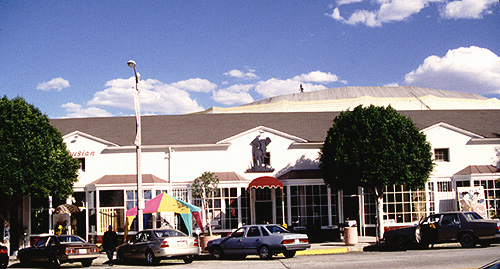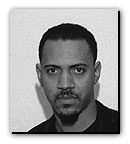

world stage - leimert park, los angeles.
home of the
World Stage Anansi Writer's
Workshop
![]()
Inside the heart of Leimert Park Village are many gathering places, but one specific hub is the World Stage. Opening in 1992, the stage is a performance space that provides a safe environment for artistic expression of all kinds for the community it serves, the surrounding Black community. World Stage is historically rich - boasting visits from jazz greats as well as well known literary figures. Inside its doors is a small stage, 50 or so chairs, and walls covered with paintings and photographs. The images are faces of jazz musicians and poets; faces of John Coltrane, Billy Higgins, and Kamaau Da'aoud.
The Stage space has multiple uses. Most notably are the jazz sessions, where performers such as jazz drummer Billy Higgins, founder of the World Stage, come to jam, provide a space for jazz lovers to come enjoy and for aspiring musicians to practice their skills. There are African drumming classes, a constantly revolving concert series and poetry classes. On Wednesday evenings from 7:30 to 10:30 the Stage holds a poetry workshop/open mike for up-and-coming poets.
From 7:30-8:30 is the workshop - a poetry workshop is where artists perform works-in-progress to the audience and when they are finished, the audience responds to the work by providing honest, positive critique. The artist is asked to take the critique with a grain of salt, using it as a method for improving their work and to think about ways in which to develop their concepts; sculpt their words, so to speak.
From 8:30-9:30 - is the featured reader, an established poet who is invited to the Stage to perform for a half-hour work they may have published and / or work they have been writing.
From The last hour, 9:30-10:30 is a traditional "open mike".
" . . . this space [is] for us to gather, to come and be honest with each other to tell our stories and to learn how to grow together. "

Michael Datcher, workshop MC and Artist-in-residence LACMA 1998
Michael Datcher is a central figure here at WS. His own evolution as a poet can be charted here with his close connection with renown poets like Kamaau Da'ooud and Peter J. Harris. In addition to being the MC on Wednesday nights poetry gathering, he is the Autumn 1998 artist-in residence for Los Angeles County Museum of Art and teaches a poetry class out of the Stage. His residency included the production of a seminar/performance series, "Renaissance(s) of Resistance: The Documentation of black Humanity as a Weapon against Oppression in Leimert park and Harlem". A free-lance writer for several magazines and journals, he is also co-editor of a book, "Tough Love: The Life and Death of Tupac Shakur".
The continued language of tradition and linguistic modes of expression and creativity are the focus when entering the World Stage. The language which structures the conversations here are concerned with communication and articulation of self. The nature of the workshop itself is extremely democratic and effective in that the rules are clearly delineated. you present a work-in-progress, read and perform it tot he audience. After you finish, there is a five to 15 minutes critique where the audience provides honest, positive and creative response. The artist is asked to take the critique and learn from it, not to get defensive and understand the nature of creative work depends of the existence of others. encourages positive critique... a gaze that is clearly Afrocentric, bold and proud of the heritage of who the Black Community is.
The structure of these three differing components of the evening provide a place for members of the black community to come and share ideas, pains, joy and love with each other.
"Aahhhh. . . the World Stage in the Crenshaw district, I went there and it was like church, a church for artists. Everyone was grooving on each others words, like we were all being fed spiritual manna . . ."(Watson, 1998)
The World Stage as a specific literary space lends to the idea of oral communication/literature as a community building device. In the 20's the Harlem renaissance writers helped build and conceptualize and vocalize a movement that changed history. The comparisons between the two are not hard to connect. ". . . the irresistible impulse of blacks to create boldly expressive art of a high quality and humanity in the face of poverty and racism." (929) Termed as an era of reconstruction, the historical Harlem Renaissance is noted as a definitive moment in time that began to shape the notion of a concrete black community. Literature and language centered in black resistance remains our focus.
The World Stage is attempting to enter into a new place within the history of Black peoples and resistence. Creating access to spaces that are built, shaped and maintained from an Afrocentric viewpoint and explore the phenomenon of community discourse, is a concete way in which to formualte community. In West African culture there exists a meeting place, The Togu Na, relative to city hall and central to the life force of the community. All manner of business and social issues are discussed here. The Togu Na, or House of Words is a discourse model that the language of the Anansi Writers Workshop parallels.
The writers use language clearly resisting against and critiquing popular culture. Providing this space where black people can feel free to get up and talk about their oppressions, fears, angers without judgment, fear of termination, rejection, is vital to the dissemination of the negative self-concept African Americans have digested.
-growth and
nurturing, creation of a community that supports each other is
the concept Dj Watson, Professor of English and Black Studies at
San Diego City College took with her to conceptualize and create
her writerz workshop - Writerz Block, a successful venue in
downtown san Diego.
(go to next page for interview
with Dj Watson)